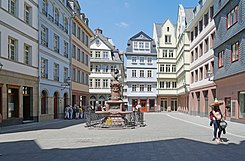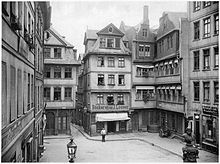Chicken market
| Chicken market | |
|---|---|
| Place in Frankfurt am Main | |
 Chicken market 2018 |
|
| Basic data | |
| place | Frankfurt am Main |
| District | Old town |
| Created | middle Ages |
| Newly designed | 2014-2017 |
| Confluent streets | Market , Behind the Lammchen , Neugasse |
| Buildings | Haus zum Esslinger , New Red House on the market |
| use | |
| Space design | Stoltze fountain |
The chicken market is a place in the old town of Frankfurt am Main on the market between the Kaiserdom and Römerberg . The chicken market was destroyed by the air raids on Frankfurt am Main in World War II and the demolition of the last remaining, burned-out buildings in the immediate post-war period. Between 1974 and 2012 the square with the technical town hall was completely built over. As part of the Dom-Römer project , the chicken market was rebuilt from 2014 to 2018 following the demolition of the Technical Town Hall with its historical floor plan and reconstructions of important old town houses.
location

The chicken market opens to the south to the Alter Markt , which as one of the main arteries of Frankfurt's old town leads from the Kaiserdom to the Römer . Today it is also referred to as the coronation path, which the Roman-German emperors traversed after their coronation in the cathedral. To the north, the Neugasse connects to the chicken market and to the west of the north side of the square is the street Hinter dem Lämmchen . All the houses on the Hühnermarkt have the address Markt , except for the north-western corner house, which already belongs to the street Hinter dem Lämmchen .
Former development

The Freydhofbrunnen , originally a large draw well , had stood on the square since the 14th century . On February 4, 1696, a maid killed her newborn child and threw the body into the well. On April 12, 1696, she was executed for murder with the executioner's sword . In 1759 the draw well was replaced by a more effective pump well with two handles. A stone goddess of freedom by the sculptor Johann Michael Datzerath stood on the sandstone column of the fountain . In 1892 the fountain, now known as the Freedom Fountain, was moved to the Weckmarkt and replaced by the Stoltze fountain, inaugurated in 1895 . After the chicken market was destroyed, the fountain was located on Stoltzeplatz behind the Katharinenkirche from 1981 to 2016 .
The development on the edge of the square included a number of well-known town houses, some of which were of greater importance for the city's history. In the following, the individual buildings on the square are described counterclockwise, starting with the easternmost house on the market.
The eastern house Neues Paradies / Mayreis (Markt 14) was a five-storey classicist stone building that replaced the previous building and was built around 1800.
The small Seligeneck (Markt 16) was a comparatively young building. The previously existing classical building was the mid-1930s by a new building in Heimatstil replaced, which has a three-storey with sgraffito ornamented bay window had.
The three-storey Schildknecht / Spiegel (Markt 18) building, built around 1405 and in its final form in the 17th century, formed the northeast corner building of the chicken market and, at almost two meters, had the largest overhang of all Frankfurt half-timbered houses. It was the building of the shoemaker's guild and, in addition to richly painted, had all the typical elements of the Renaissance.
The Haus zur Flechte / Alt Friesenstein / Klein Friesenstein (Markt 20 / Neugasse 2) was characterized by the legibility of its long building history.
Of particular importance as one of Frankfurt's Goethe locations was the young Esslinger (Hinter dem Lämmchen 2), because the house built in the 16th century with plastered half-timbering was inhabited by Goethe's aunt Johanna Melber . Goethe put her in Out of my life. Poetry and Truth a literary monument .
The Goldene Schere house (Markt 22 / Hinter dem Lämmchen 1), the last state in classicist forms with plastered half-timbering, was built in the 18th century. It united two smaller houses in the adjoining alley behind the Lammchen. It is an extremely interesting mixed building because, contrary to the design facing the chicken market, the characteristic offset of the floors towards the alley was retained.
The classicist house Eichhorn (Markt 24) was built on a very small plot.
The Haus zum Schlegel (Markt 26) was a four-story, classicist building built in 1830.
Post-war development
After the destruction in the war and the removal of the rubble by 1950, the area remained a wasteland for a long time, despite a competition held in 1963 to redesign the Dom-Römer area. It was not until the beginning of the 1970s, with the construction of the Dom / Römer underground station , that the Technical Town Hall was built here, a concrete building of brutalism . Large parts of the city's population were hostile to this building from the very beginning. In 1994 the city sold the Technical Town Hall for 12 years as part of a lease back sale process . In 2006, the city council decided, due to the poor quality of the urban space, the scarcely existing reference to the historic old town and major structural defects, to buy back the building at the end of the rental period and to tear it down. In its place, as part of the Dom-Römer project, a historicizing, small-scale development with the most accurate possible restoration of the historical road network was to be created. After the Technical City Hall was demolished from 2010 to 2012, the foundation stone for the reconstruction was laid in January 2012.
Reconstruction of the chicken market
As part of the Dom-Römer project, eight of eleven houses on the Hühnermarkt were reconstructed: on the south side from east to west are the buildings Markt 13 Grüne Linde , a replica of a baroque inn building with a rear building, Markt 15 Rotes Haus , and Markt 17 Neues Rotes House .
On the west side, the classicist houses Markt 22 Goldene Schere , a four-story building with an octagonal roof lantern , were built from north to south , Markt 24 Eichhorn , an eaves-standing house, and Markt 26 Schlegel , a three-story corner house.
The north side consists of the reconstructed houses at Markt 20 Zur Flechte , a gothic half-timbered house with a baroque dwelling , east of Neugasse, and west of it the Haus zum Esslinger (Hinter dem Lämmchen 2).
Only the houses on the east side are new buildings. Markt 14 (Neues Paradies) was designed by Johannes Götz and Guido Lohmann, Cologne, Markt 16 (Kleines Seligeneck) by Van den Valentyn-Architektur, Cologne, and the northeast corner house Markt 18 (Haus Schildknecht) by dreibund architekten, ballerstedt, helms, koblank, Bochum.
On September 20, 2013 the Frankfurt magistrate decided to put the Stoltze fountain back on the newly built chicken market; this happened in September 2017. From 1981 to 2016 he stood on Friedrich-Stoltze-Platz behind the Katharinenkirche .
The Stoltze memorial was located behind the Katharinenkirche from 1981 to 2016
See also
- History of Frankfurt am Main
- Frankfurt old town
- New Frankfurt old town
- Models of Frankfurt's old town: Treuner's old town model , virtual old town model Frankfurt am Main
literature
- Dietrich-Wilhelm Dreysse, Volkmar Hepp, Björn Wissenbach, Peter Bierling: Planning area Dom - Römer. Documentation old town. City Planning Office of the City of Frankfurt am Main, Frankfurt am Main 2006, House 40 (p. 75) and House 41 (p. 76f.) ( Online ; PDF; 14.8 MB)
Web links
- Views of the old town of Frankfurt am Main. altfrankfurt.com
- Reconstruction of old town buildings on the area of the Technical Town Hall - documentation of the city of Frankfurt am Main v. October 2006 (PDF) (14.14 MB)
- Website of the Dom-Römer project
Individual evidence
- ↑ Reconstruction of old town buildings on the area of the Technical Town Hall - documentation of the city of Frankfurt am Main v. October 2006 (PDF) (14.14 MB)
- ↑ Green linden tree
- ↑ Red House
- ↑ New Red House
- ↑ Golden Scissors
- ↑ Eichhorn
- ↑ Schlegel
- ↑ To lichen
- ↑ Esslinger
- ↑ New Paradise
- ↑ Little Seligeneck
- ^ House Schildknecht
Coordinates: 50 ° 6 ′ 39 ″ N , 8 ° 41 ′ 1 ″ E






